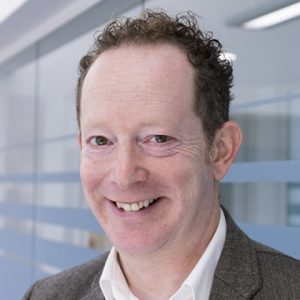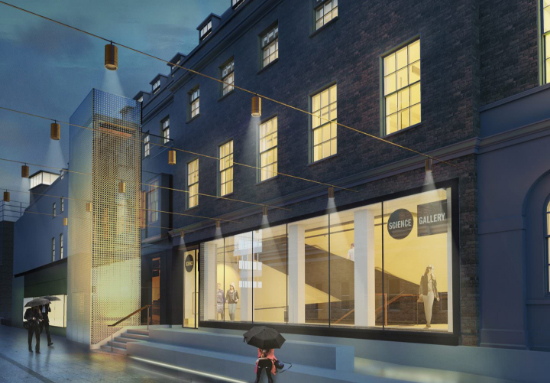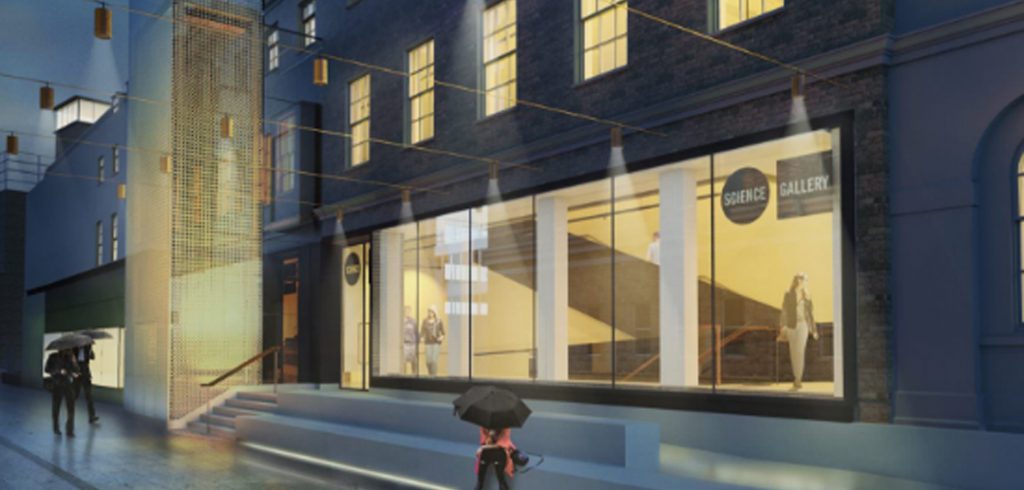"Continuo a pensare che la scienza cerchi delle risposte e l'arte delle domande". - Marc Quinn
Aiming to bridge the gap between science and art, King’s College London is all set to open Galleria della Scienza di Londra, a new space in the heart of the capital, where ‘science and art collide’. The gallery is part of the Global Science Gallery Network and will open its doors to the public in 2018. The free-to-visit space seeks to spark creative thinking and innovation, through collaborations not only between scientists and artists, but also between local communities, students, educators, young researchers, and people like you and me. The gallery will host exhibitions, events, live experiments and interactive discussions, serving as a channel through which King’s researchers can connect and engage with the outside world.

Dr. Daniel Glaser | Immagine: © Kate Anderson, courtesy Science Gallery London
The Director of Science Gallery London, Dr. Daniel Glaser, is a neuroscientist, and former head of Engaging Science at Wellcome Trust. He was also the first scientist to serve as a judge for the Man Book Prize, and was the first Scientist in Residence at the Institute of Contemporary Arts in London. I chat with Dr. Glaser over the phone about Science Gallery’s vision, and the need for interdisciplinary collaboration.
RS: Come è nata l'idea della Galleria della Scienza? Che bisogno c'era di uno spazio come questo?
DG: La Science Gallery è stata avviata a Dublino nel 2008. La sua necessità deriva da una combinazione di due cose. È nata da una progressione di un movimento artistico che combinava scienza e arte - l'idea era che queste due discipline non dovessero essere separate. Era anche il risultato di una lunga progressione di lavoro finanziato da persone come il Wellcome Trust - dove i prodotti artistici aiutavano le persone a connettersi alla scienza.
The second motivation for us at King’s is for the university to be able to connect to the city. We’ve got the gallery on the corner of the campus on a very busy street, so it’s a mechanism or a channel through which we can connect with the city.

An architect’s representation of Science Gallery London | © LTS Architects, Courtesy Science Gallery London
RS: Why do you think it’s important for scientists and artists to collaborate?
DG: The right way to think about it would be to think of the concept of interdisciplinarity. If we want to make progress in society, in science, in art, and in life – we need to have people from different backgrounds and traditions freely engage and interact with each other. We have different beliefs, different ways of talking and acting, there are differences in religion, nationality, scientific practice, art, etc. If a university has to thrive, if ricerca has to thrive and the problems of society have to be solved, then we need to have these spaces where people from different perspectives come together.
Non stiamo parlando solo di biologi e chimici, ma anche di nanotecnologi, ingegneri e designer. Dyson fa prodotti di ingegneria, (Sir) Jonathan Ive, il designer dell'iPhone, è una persona con un background di design che lavora per un'azienda tecnologica. Dobbiamo incoraggiare questo tipo di collaborazione.
RS: Ho letto sul sito della KCL che la galleria si concentra sul raggiungimento dei 15-25 anni e che vi rivolgete a loro per avere idee sulle nuove proposte. Perché proprio quella fascia d'età?
DG: Quindi ci sono due ragioni. Permettetemi di chiedervi che età volete avere?
RS: 22!
DG: Exactly, mine’s 24 – that’s actually the median age. Both groups – younger and older – who were asked this question, pick this age range. This is also an under-served age group. Typically science museums are targetted to a much younger age group, whereas the more serious exhibitions involve scientists having a panel discussion after which we share a glass of wine – this age group falls in between the two.
Per la nostra prima mostra sulla dipendenza, Hooked, con cui apriamo nel 2018, abbiamo chiesto a questa fascia d'età cosa pensassero della dipendenza. Ci aspettavamo risposte sull'eroina, sull'iniezione di droghe e sull'alcol. Ma riuscite a indovinare di cosa hanno parlato?
RS: I telefoni?
DG: Exactly, mobile phones and social media. So when we open, the exhibition will not only focus on alcohol and drugs but also things that we didn’t think of as obvious themes. Young people bring in a new perspective.
RS: Se sono fuori dal gruppo di età posso comunque inviare una proposta?
DG: Absolutely. Also, we aim for 40% of our audience to be within the age group of 15-25 and the rest are outside that bracket. We have an open proposals system where just about anyone can send in a proposal. You needn’t have to be in that age group.
Ma una volta che decidiamo un tema, la prima cosa che facciamo è uscire e chiedere ai 15-25enni cosa ne pensano.
RS: Quali sono i vostri criteri per commissionare i progetti?
Well, the person who takes the call is someone who’s had curatorial experience, someone who’s had years of experience in putting on exhibitions. So far, the problem with SciArt galleries was that we had a scientist or, even worse, an admin making the decision but that’s not how it is here. Of course, the project has to have eccellenza artistica e dovrebbe essere eccitante e coinvolgente per un pubblico giovane.
Non solo mostriamo i lavori che arrivano attraverso le chiamate aperte, ma mostriamo anche altri progetti, per completarli.
RS: How do you get somebody who’s not in the UK to engage with this space?
DG: Anyone from any part of the world can make a proposal – we’ve commissioned projects from Taiwan, China, Italy – the world over. Though we say the proposals system is ‘open’, we typically get proposals from people who understand science and art. We also expect the ideas to engage underactive groups.
RS: Ho letto del progetto spit crystal. Pensi che le domande/conclusioni che vengono fuori da questo tipo di progetti stimoleranno la ricerca e l'innovazione alla KCL e fuori?
DG: I’m really glad you bring up the spit crystal because it’s one of the most fascinating projects we’ve had. We had Inés Cámara Leret, a young artist in her 20s, send in this proposal. At the gallery, she ended up meeting Brian Sutton, a senior professor of X-ray crystallography, who worked under the same supervisor as Rosalind Franklin. Now, Inés was making the crystal not just by spit but by adding alum to it. Professor Brian Sutton was so intrigued that he now has actually got a postdoc working with him on generating spit crystals from protein in the saliva.
We’ve had lots of such examples, but not every artistic idea will go through the same interaction. It’s not something that happens automatically – you need the right kind of experienced mentors who can take the idea forward. What we want is for projects to raise questions that enable us to look at the world around us in a different light.
RS: Come è stata finora la risposta alle mostre?
DG: We’ve been doing pop ups all over the city. I’ve been in this field for about 20 years now, and I can say that the response has been extremely positive. We’ve had hundreds to thousands of people looking at artworks and thinking about themselves and the world around them in a different way.
Abbiamo anche studenti mediatori della KCL che paghiamo per interagire con i visitatori. Abbiamo assistito a una di queste interazioni durante il fine settimana ed è stato assolutamente affascinante osservare la conversazione tra il pubblico e gli studenti. C'erano così tante domande che ne sono venute fuori - e penso che queste domande siano essenziali per fare progressi.
La Science Gallery di Londra ospita una mostra e una serie di eventi, Blood: Life Uncut , dal 27.07.17 - 1.11.17, che esplora i diversi modi in cui il sangue può affascinare e riunire le persone.
RS: Nel suo discorso all'EHD2017, lei ha menzionato che l'interdisciplinarità riguarda l'ignoranza. Pensi che un posto come la Science Gallery di Londra aiuti a rimuovere questa ignoranza e a rendere la ricerca più inclusiva?
DG: Well, I don’t think we should rimuovere ignorance. By ignorance, I mean the disciplines we specialise in – we all think and speak a certain way, we interact with others who think like us. Discipline refers to expertise or knowledge in one particular area. That is inhomogenous too – its not the same everywhere. So, I don’t think that we should be removing this ignorance, but we should be permitted to ask questions.
Often, stupid questions are the best ones. In English, we even say it to defend ourselves – “Ah, this is probably a stupid question” – but these questions are the ones that are critical for us to make progress. ‘Ignorance’ is a new energy source for us to capitalize on.
RS: Pensi che il futuro della scienza sia la collaborazione? Lo chiedo soprattutto perché lavoro per un'organizzazione che incoraggia la collaborazione interdisciplinare.
DG: Yes, but I don’t think the majority of papers should be about that. When I started doing a PhD in neuroscienze, there were no professors studying neuroscience, the term didn’t really exist. Disciplines shift over time, and not all collaborations are fruitful. Not all survive.
What I think is important is periodic engagement outside your comfort zone. If you’re a researcher, you spend most of your time in the lab, talking to people who think just like you. When you get out of that zone, you start to make progress. We are so comfortable in our space – I think exploring and engaging with the world outside of it is important.
RS: C'è qualche messaggio che vorrebbe condividere con i giovani ricercatori e artisti?
DG: Well. I’d say, be brave and respectful, which are also the values of the Science Gallery. Look for ways to connect with others, and participate. Most importantly, never be scared to surprise yourself and others.
—————————-
Leggi di più sugli eventi in corso alla Science Gallery di Londra qui.
